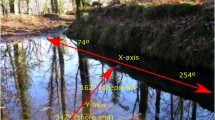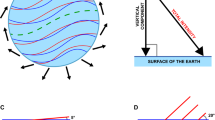Summary
Laboratory tests were carried out to examine the orientation behavior of adult Eastern red-spotted newts (Notophthalmus viridescens) to earth-strength magnetic fields. Groups of 30 to 40 newts were housed in water-filled, all-glass aquaria with an artificial shoreline at one end. The aquaria were located in a greenhouse or outdoors adjacent to the laboratory building, and aligned on either the magnetic north-south or east-west axis. Tests were carried out in an enclosed indoor arena. Newts were tested in four horizontal alignments of the magnetic field: the ambient magnetic field (magnetic north at North) and three altered fields (magnetic north rotated to East, South or West). Data were analyzed after pooling the magnetic bearings from all four conditions in such a way as to retain the component of the newts' orientation that was a consistent response to the magnetic field. Elevation of training tank water temperature was used to increase the newts' motivation to orient in the direction of shore. Newts exposed to a training tank water temperature of 33–34 °C just prior to testing exhibited consistent unimodal magnetic compass orientation. The direction of orientation was altered predictably by changing training tank alignment and location relative to the laboratory building. The results provide the first evidence of a strong, replicable magnetic compass response in a terrestrial vertebrate under controlled laboratory conditions. Further, the present study demonstrates that the Eastern newt is able to learn a directional response relative to the earth's magnetic field.
Similar content being viewed by others
References
Able KP (1980) Mechanisms of orientation, navigation and homing. In: Gauthreaux SA (ed) Animal migration, orientation and navigation, pp 284–373
Adler K (1976) Extraocular photoreception in amphibians. Photochem Photobiol 23:275–298
Baker RR (1981) Human navigation and the sixth sense. Hodder & Stoughton, London
Batschelet E (1981) Circular statistics in biology. Academic Press, New York
Beason RC, Nichols JE (1984) Magnetic orientation and magnetically sensitive material in a transequatorial migratory bird. Nature 309:151–153
Bingman VP (1981) Ontogeny of a multiple stimulus orientation system in the savannah sparrow (Passerculus sandwichensis). Ph. D. Thesis, State Univ. New York, p 116
Bingman VP (1983) Magnetic field orientation of migratory savannah sparrows with different first summer experience. Behaviour 87:43–53
Conant R (1975) A field guide to reptiles and amphibians of eastern and central North America. Houghton Mifflin, Boston
Emlen ST, Wiltschko W, Demong NJ, Wiltschko R, Bergman S (1976) Magnetic direction finding: Evidence for its use in migratory Indigo Buntings. Science 193:505–508
Ferguson DE (1971) The sensory basis of orientation in amphibians. Ann NY Acad Sci 188:30–36
Gill DE (1978) Effective population size and interdemic migration rates in a metapopulation of the red-spotted newt,Notophthalmus viridescens (Rafinesque). Evolution 32:839–849
Gill DE (1979) Density dependence and homing behavior in adult red-spotted newtsNotophthalmus viridescens (Rafinesque). Ecology 60:800–813
Gould JL, Able KA (1981) Human homing: an elusive phenomenon. Science 212:1061–1065
Griffin DR (1982) Ecology of migration: Is magnetic orientation a reality. Q Rev Biol 57:293–295
Healey WR (1973) Life history variation and the growth of juvenileNotophthalmus viridescens from Massachusetts. Copeia 1973:641–647
Healey WR (1974) Population consequences of alternative life histories inNotophthalmus viridescens. Copeia 1974:221–229
Kreithen ML, Keeton WT (1974) Attempts to condition homing pigeons to magnetic stimuli. J Comp Physiol 91:355–362
Lemkau PJ (1976) An attempt to condition the green turtle,Chelonia mydas, to magnetic fields. M.S. Thesis, Univ. Rhode Island, p 51
Mather JG, Baker RR (1981) Magnetic sense of direction in woodmice for route-based navigation. Nature 291:152–155
Ossenkopp K, Barbeito R (1978) Bird orientation and the geomagnetic field: A review. Neurosci Biobehav Rev 2:255–270
Phillips JB (1977) Use of the earth's magnetic field by orienting cave salamanders (Eurycea lucifuga). J Comp Physiol 121:273–288
Phillips JB (1986) Homing orientation by the Eastern red-spotted newt (Notophthalmus viridescens). Behav Ecol Sociobiol (submitted for publication)
Phillips JB, Waldvogel JA (1982) Reflected light cues generate the short-term deflector-loft effect. In: Papi F, Wallraff H (eds) Avian navigation, Springer, Berlin Heidelberg New York, pp 179–189
Quinn TP (1980) Evidence for celestial and magnetic compass orientation in lake migrating sockeye salmon fry. J Comp Physiol 137:243–248
Quinn TP, Groot C (1984) The effect of water flow rate on bimodal orientation of juvenile chum salmon,Oncorhychus keta. Anim Behav 32:628–629
Quinn TP, Merrill RT, Brannon EL (1981) Magnetic field detection in sockeye salmon. J Exp Zool 217:137–142
Rodda GH (1984) Orientation and navigation of juvenile alligators: Evidence for magnetic sensitivity. J Comp Physiol A 154:649–658
Rubens SM (1945) Cube surface coil for producing uniform magnetic field. Rev Sci Instr 16:243–245
Taylor DH, Auburn TS (1978) Orientation of amphibians by linearly polarized light. In: Schmidt-Koenig K Keeton WT (eds) Animal Migration, Navigation and Homing. Springer, Berlin Heidelberg New York
Tesch FW (1974) Influence of geomagnetism and salinity on the directional choice of eels. Helgol Wiss Meeresunters 26:382–395
Visalberghi E, Alleva E (1979) Magnetic influences on pigeon homing. Biol Bull 156:246–256
Walcott C, Green RP (1974) Orientation of homing pigeons altered by a change in the direction of an applied magnetic field. Science 184:180–182
Wiltschko W (1983) Compasses used by birds. Comp Biochem Physiol 76A:709–717
Wiltschko W, Wiltschko R (1976) Interrelationship of magnetic compass and star orientation in night-migrating birds. J Comp Physiol 109:91–99
Wiltschko W, Wiltschko R, Keeton WT, Madden R (1983) Growing up in an altered magnetic field affects the initial orientation of young homing pigeons. Behav Ecol Sociobiol 12:135–142
Author information
Authors and Affiliations
Rights and permissions
About this article
Cite this article
Phillips, J.B. Magnetic compass orientation in the Eastern red-spotted newt (Notophthalmus viridescens). J. Comp. Physiol. 158, 103–109 (1986). https://doi.org/10.1007/BF00614524
Accepted:
Issue Date:
DOI: https://doi.org/10.1007/BF00614524




